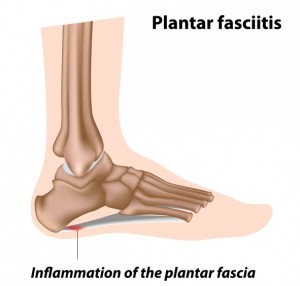Plantar Fasciitis
What is plantar fasciitis?
 The bottom of the foot contains a band of tissue called the plantar fascia that spans from the heel to the pads of the toes. When this band becomes irritated and inflamed it can produce uncomfortable pain in the heel called plantar fasciitis. While this is not the only possible cause of heel pain, it is the most common source.
The bottom of the foot contains a band of tissue called the plantar fascia that spans from the heel to the pads of the toes. When this band becomes irritated and inflamed it can produce uncomfortable pain in the heel called plantar fasciitis. While this is not the only possible cause of heel pain, it is the most common source.
What causes plantar fasciitis?
Heel pain caused by plantar fasciitis, also sometimes referred to as heel spur syndrome, is caused by irritation to the plantar fascia, which results in painful inflammation. Most often, this condition is due to your foot structure, specifically those individuals who have flat feet or high arches.
What are the symptoms of plantar fasciitis?
If you have plantar fasciitis, you will likely experience:
- Pain in the bottom of the heel
- Pain in the arch
- Pain that worsens when walking, standing up or after long periods of standing
- Pain or stiffness in the morning or after long periods of sitting
Typically, pain from plantar fasciitis will gradually worsen over a period of months. While it may be especially painful in the morning, symptoms usually improve slightly after walking around, as this helps to stretch out the tissues.
What are the risk factors for plantar fasciitis?
There are several factors that can increase your risk for plantar fasciitis:
- Age – most cases of plantar fasciitis occur between the ages of 40 and 60
- Physical conditions – conditions including flat feet, a high arch and obesity can increase the strain placed on the plantar fascia leading to inflammation
- Long hours spent standing – jobs or activities that require long periods on the feet may place you at a higher risk for plantar fasciitis
- Non-supportive footwear – wearing shoes that do not provide a supportive sole with proper cushioning can make you more prone to this condition
- Sports involvement – running and other high impact sports increase the odds of developing heel pain
What are the treatment options for plantar fasciitis?
If you are experiencing chronic heel pain, call our office at 212‑434‑4920 or fill out the schedule appointment form on this page so Stuart Katchis, M.D. can evaluate and diagnose your condition. Plantar fasciitis is fully treatable without surgery for most patients and treatment outcomes are significantly improved if medical evaluation is sought when symptoms first start.
Nonsurgical Treatment
Nonsurgical treatment options may take several months to fully take effect, depending on the course(s) of treatment taken and how long you were experiencing pain prior to seeking medical attention.
Nonsurgical treatment options may involve:
Resting
The first and most important step to recovery is stopping or reducing all activities that make the pain worse, particularly those activities that place repetitive pressure on the heel and plantar fascia
Applying ice
Applying ice to the injured area will help reduce pain and inflammation.
Taking anti-inflammatory medications
Taking over-the-counter anti-inflammatory medications can considerably reduce pain. If necessary, Dr. Katchis may prescribe a stronger medication to help with inflammation and pain.
Altering footwear
Wearing shoes that offer soft, supportive soles with a slightly raised heel will stabilize the injured foot and reduce strain on the plantar fascia.
Using orthotics
Inserts placed in the shoes can help relieve pain by repositioning the foot and reducing pressure on the heel and plantar fascia.
Wearing a splint at night
A splint can help position the affected tissues in a stretched position during sleep so that pain is not as severe in the morning.
Getting cortisone injections
Cortisone shots injected into the affected area may significantly reduce pain and discomfort.
Physical therapy
There are a number of stretches and strengthening exercises that can aid and sometimes even accelerate the recovery process. Dr. Katchis may recommend that patients see a physical therapist for treatment.
Shock wave therapy
If plantar fasciitis is a chronic problem, sound wave therapy may be implemented to stimulate healing.
Surgical Treatment
If conservative treatment options do not relieve symptoms after several months, Stuart Katchis, M.D. may recommend surgery. While rare, a surgery may be performed that permanently detaches the plantar fascia from the heel bone to eliminate severe pain.
What does the recovery process entail?
Recovery times will vary depending on the severity of each patient’s condition. Whether you undergo nonsurgical or surgical treatment for plantar fasciitis, Dr. Katchis will provide recommendations for long-term measures designed to keep your symptoms from returning, such as footwear modifications, wearing orthotics and performing regular stretching exercises.




You must be logged in to post a comment.